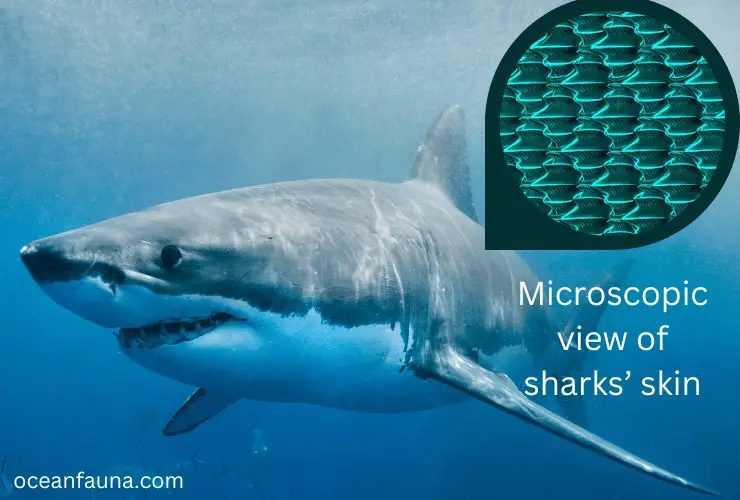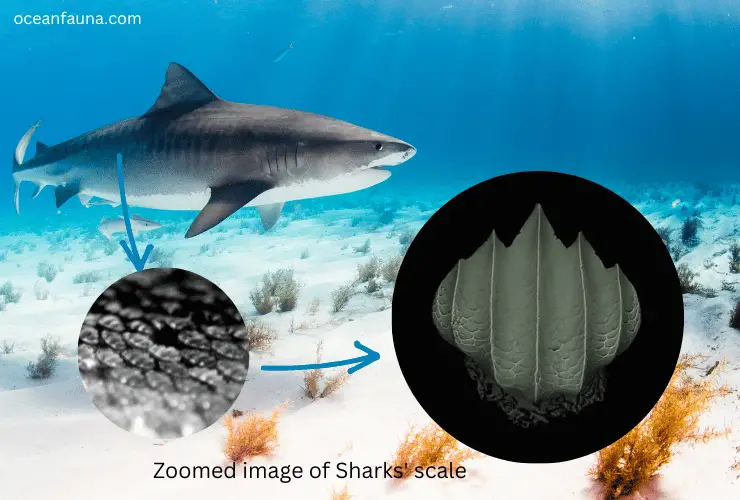Curious about shark skin and scale? Do sharks have scales?
Well, the answer is yes! But hold on; their scales are unlike those of other fish. So, what makes them so unique? Dive into this article as I unravel the fascinating details for you!
Do Sharks Have Scales?
Sharks indeed have scales, but they’re not your typical fish scales. These remarkable creatures possess something truly extraordinary – dermal denticles or placoid scales. Picture this: thousands of teeny flat V-shaped scales covering their skin, akin to a sandpaper sensation. These scales, more akin to teeth than fish scales, are composed of dentine and enamel – just like our pearly whites. Fascinating, isn’t it?
The purpose of these unique scales is to protect sharks from predators, parasites, and other external threats. Dermal denticles have an abrasive texture that helps reduce drag when the shark moves through the water. This feature allows sharks to swim faster and more efficiently than other ocean fish.
Additionally, the scales provide a hydrodynamic advantage by reducing turbulence around the shark, making its movements through the water more streamlined.
Interestingly, the structure of these scales is similar to that of human teeth, and there is an ongoing effort to develop materials based on this biological inspiration. Researchers are exploring the use of shark scale-inspired products in fields ranging from aerospace to medical implants.
What Are Sharks’ Scales Called?

Sharks, as well as some other cartilaginous fishes, have specialized scales known as dermal denticles. These placoid scales cover the shark’s entire body and are essential for its survival. Dermal denticles are small, leaf-shaped structures that provide the shark with both protection and hydrodynamic advantages.
Dermal denticles are unique in their structure and consist of a crown, which is a flattened, tooth-like structure, and a base, which is embedded in the shark’s skin. The crown of the denticle is covered with hard enamel, making it extremely hard and durable. This hard layer of enamel protects the shark’s skin against damage from parasites, prey, or other predatory animals.
The base of the denticle is made up of a pulp cavity connected to a nerve and blood supply. This cavity is surrounded by a hard layer of dentin and covered with a thin layer of skin tissue. These nerves help the shark sense movement and vibrations in the surrounding water, which is essential for hunting and navigation.
Dermal denticles are also instrumental in reducing drag and increasing hydrodynamic efficiency. The structure of the denticles enables them to reduce the turbulence of water flow along the skin of the shark. It also reduces the pressure drag and energy required to move through the water, enabling sharks to swim faster and more efficiently.

What Are the Uses of Shark Scales?
Shark scales, also known as dermal denticles, are an essential adaptation that plays a crucial role in the survival of these apex predators. The multifunctional nature of these scales is a testament to the ingenuity of evolution, which has equipped sharks with unique features that enhance their predatory capabilities.
Hydrodynamic Advantage
One of the most significant uses of shark scales is their ability to provide a hydrodynamic advantage to the animal. The unique arrangement of the scales and their abrasive texture helps reduce turbulence around the shark’s body, enabling it to move through the water more smoothly and efficiently.
This feature is especially vital for sharks since they are known to be fast swimmers, and the drag caused by the water can significantly impact their speed and maneuverability.
Protection from Predators and Parasites
Shark scales’ abrasive texture also acts as a protective shield against potential predators and parasites. The scales can deter parasites from attaching themselves to the shark’s skin, preventing infections and other health issues. Moreover, the scales’ unique structure makes it difficult for predators to get a firm grip on the shark, reducing the risk of them getting injured or caught.
Improved Sensory Perception
The scales’ arrangement on the shark’s skin also enhances its sensory perception. The tiny pores located between the scales contain electroreceptor cells that help sharks detect electrical fields produced by their prey.
These sensory organs, known as the ampullae of Lorenzini, are essential for sharks’ predatory behavior, as they allow them to locate their prey more accurately, even in murky waters.
Thermoregulation
Shark scales also play a role in regulating the animal’s body temperature. The scales’ shape and size enable the shark to trap a layer of water close to its skin, creating a barrier that insulates it from the cold water around it.
This feature is vital for sharks that inhabit colder waters, ensuring they maintain their body temperature to efficiently carry out their metabolic processes.
What Are the Differences in Scales Between Sharks and Other Fish?

Sharks, being a unique type of fish, have many distinct features regarding their anatomy, including their scales. In the following sections, we will discuss the differences between shark scales and the scales of other regular fish.
Scales Arrangement
Most fish have overlapping scales that act like tiles on a roof. However, shark scales arrange themselves in a single layer, interlocked and structured like a jigsaw puzzle, which provides additional protection to the shark. The scales’ arrangement restricts friction between water and shark skin and produces less noise while swimming.
Denticles
Denticles are small, tooth-like structures that cover the shark’s skin and perform many functions. Unlike regular scales, denticles reduce drag and turbulence by forming tiny vortices that aid in swimming and give the shark its unique ability to move swiftly through the water. These denticles improve the shark’s agility and make them more efficient hunters.
Material Composition
Shark scales are made of dermal dentin, a material much harder than the enamel on regular fish scales. It is one of the hardest materials found in the animal kingdom. The texture of the dermal dentin reduces turbulence, which is very advantageous while swimming in water.
Furthermore, the scales are not limited to protection alone but have countless benefits, including acting as sensory receptors, allowing the shark to detect electrical fields and improve its sense of touch and smell.
Scales Thickness
Shark scales are thicker than those of regular fish, and they offer superior protection to their bodies. These scales are arranged defensively and serve to repel potential predators that might attack the shark.
Though the scales’ primary function is protection, they have additional purposes, such as helping reduce friction and ultimately improving swimming efficiency.
Do All Sharks Have Scales?

Yes, all sharks have the same type of placoid scale. These scales are unique to sharks and differ from those on bony fish. While the size, shape, and number of scales vary between species, it is safe to say that all sharks have scales.
However, not all of these scales are visible on the surface of a shark’s skin. Some of these scales, known as dermal denticles, are embedded in the skin. These dermal denticles are small, tooth-like structures that are composed of dentin and covered in enamel-like material.
The presence of scales on a shark’s skin serves several important functions. First, these scales help to reduce drag while swimming in water. This is partly due to the fact that the scales’ rough texture creates tiny vortices in the water, reducing the amount of friction between the shark and the surrounding water.
Additionally, all sharks have special mucus glands located beneath their scales. These glands produce oily slime that covers the shark’s skin. This slime helps to reduce drag and aids in buoyancy control, but it also serves to protect the shark from parasites and other forms of infection.
Are Sharks’ Scales Dangerous?
Shark scales are not sufficiently sharp to penetrate or cut human skin. Thus, they are not deemed hazardous in this respect. Nevertheless, it is imperative to exercise prudence and maintain a safe distance from sharks while swimming or participating in any water-based activities.
Although shark scales are not sharp, they can still cause irritation or bruising if they come in contact with the skin. This is because the scales are rough and abrasive and can rub against the skin with enough force to cause discomfort. In addition, shark scales can become entangled in clothing or other items, which could result in a scratch or bruise.
Different species of sharks have different types of scales. For example, some sharks have tiny teeth embedded in their skin, called dermal denticles, which can be sharper than traditional scales. However, these are still not considered dangerous to humans unless you come in direct contact with them, which is unlikely to happen while swimming.
Conclusion
Hopefully, you have a clear understanding of sharks’ scales. If you want to learn more about sharks and their anatomy, it is highly recommended that you visit your local aquarium or a museum dedicated to marine life. It’s an educational and enjoyable experience that can help you better understand the majestic creatures that inhabit our oceans. With this knowledge in mind, you can appreciate these animals even more on your next trip to the beach!


1 thought on “Do Sharks Have Scales? [Answered]”